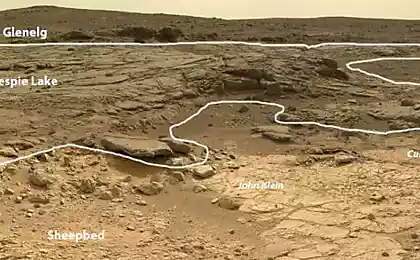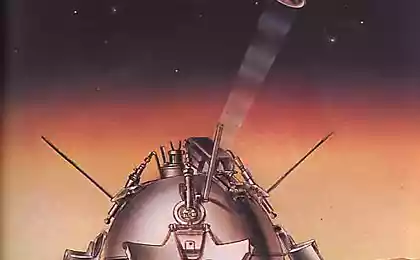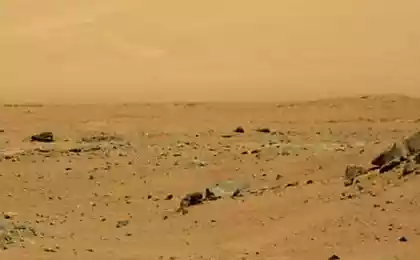1314
Curiosity began to study the Martian soil
Analysis of the soil did not start immediately, but only two months after the arrival of the rover Curiosity on Mars.
This is due to technical problems that have occurred at the time of collection of the soil.
A piece of plastic pulled away from the rover, scientists have decided not to risk it, so as not to scoop the stuff of terrestrial origin and repeat the procedure again.
The process was delayed, but still proceeded to sample the special chemical and mineralogical laboratory CheMin inside Curiosity.
The first pictures from Mars rover "Kyuriositi" (20 pics + 1 video)
Planetary rovers to Mars Curiosity went

Rocknest («nest in the rocks") - a small sandy sediments and accumulation of stones in the path of the rover. This location was chosen for taking soil samples.

Panorama section Rocknest. The purpose of Curiosity - a small sand deposited in the foreground.

Traces of Curiosity on the crest of deposits. Many in the West have already compared this picture with photos next man on the moon

Martian regolith. Next Curiosity from the wheels to the left. The rover has driven into the sand applied to bare rock, located just beneath the surface. The picture got the right camera MastCam October 5, 2012

Dry and dusty Martian regolith closeup. Despite the freezing temperatures, the ground does not freeze, because there is almost no water. It is this kind of material was in gruntozabornike Curiosity

The soil unit Curiosity is a small ladle 7 cm long and 4, 5 cm wide, mounted on the end of the robotic arm.

The first trial was not designed to analyze. Rover while shaking it in a ladle in order to remove it from the inner surface of possible dust particles and other small particles that can be recorded on Mars with the Earth. If such particles are not removed, as listed with the Martian soil into the chamber for chemical analysis, they can distort the results of the study. After this procedure, the soil was thrown. In the foreground of the picture is seen a shiny object lying on the ground, which is very interested scientists
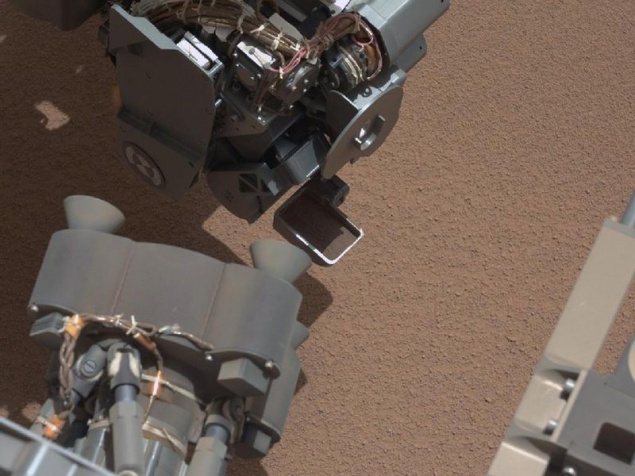
On closer inspection, the object turned out to be a piece of plastic that fell from Curiosity. This is probably part of the winding of one of the plurality of cables stretching from outside the body of the rover.

Panorama of Mars view from space of soil sampling

The second soil sampling was carried out on October 12. After the discovery of plastic fell from Curiosity, scientists are very attentive to this procedure, carefully examining how to take soil samples and place cherpka. The one who searches always finds: among the sand and dust, they found several suspicious shiny objects ranging from 0 5 to 2 mm. Subsequently, it was found that these objects are light and have minerals Martian origin, however, not wanting to risk, the researchers threw a second fence and 15 October gave the rover team to make a third. It was he who proceeded to the chamber for chemical analysis.

Curiosity on the sandy sediment. The image was obtained on the 60th day of stay the rover on Mars.
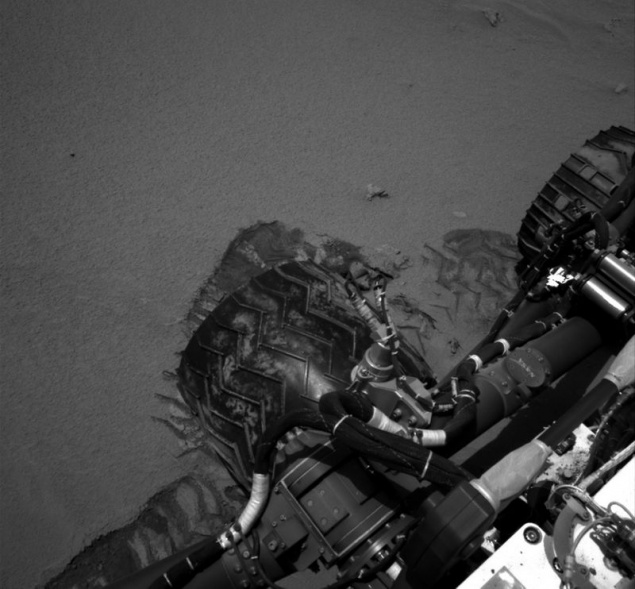
Looking at their own wheels. Snapshot to get a camera MAHLI (Mars Hand Lens Imager) October 6, 2012

Another view of the Martian soil in high resolution. The image was obtained by the camera MAHLI, which is only 12 centimeters from the surface. The site caught on the picture has a size of 8 x 6 cm.

The bottom of the crater Gale, which conducts research Curiosity. Curiosity We have time to take pictures of the Martian desert landscape as a chemical analysis will continue day. The purpose of this research - to determine the environmental conditions that occurred in the crater in the distant past. Chemical analysis will also show whether there is in the Martian regolith ingredients necessary for life

Source: trasyy.livejournal.com
This is due to technical problems that have occurred at the time of collection of the soil.
A piece of plastic pulled away from the rover, scientists have decided not to risk it, so as not to scoop the stuff of terrestrial origin and repeat the procedure again.
The process was delayed, but still proceeded to sample the special chemical and mineralogical laboratory CheMin inside Curiosity.
The first pictures from Mars rover "Kyuriositi" (20 pics + 1 video)
Planetary rovers to Mars Curiosity went

Rocknest («nest in the rocks") - a small sandy sediments and accumulation of stones in the path of the rover. This location was chosen for taking soil samples.

Panorama section Rocknest. The purpose of Curiosity - a small sand deposited in the foreground.

Traces of Curiosity on the crest of deposits. Many in the West have already compared this picture with photos next man on the moon

Martian regolith. Next Curiosity from the wheels to the left. The rover has driven into the sand applied to bare rock, located just beneath the surface. The picture got the right camera MastCam October 5, 2012

Dry and dusty Martian regolith closeup. Despite the freezing temperatures, the ground does not freeze, because there is almost no water. It is this kind of material was in gruntozabornike Curiosity

The soil unit Curiosity is a small ladle 7 cm long and 4, 5 cm wide, mounted on the end of the robotic arm.

The first trial was not designed to analyze. Rover while shaking it in a ladle in order to remove it from the inner surface of possible dust particles and other small particles that can be recorded on Mars with the Earth. If such particles are not removed, as listed with the Martian soil into the chamber for chemical analysis, they can distort the results of the study. After this procedure, the soil was thrown. In the foreground of the picture is seen a shiny object lying on the ground, which is very interested scientists

On closer inspection, the object turned out to be a piece of plastic that fell from Curiosity. This is probably part of the winding of one of the plurality of cables stretching from outside the body of the rover.

Panorama of Mars view from space of soil sampling

The second soil sampling was carried out on October 12. After the discovery of plastic fell from Curiosity, scientists are very attentive to this procedure, carefully examining how to take soil samples and place cherpka. The one who searches always finds: among the sand and dust, they found several suspicious shiny objects ranging from 0 5 to 2 mm. Subsequently, it was found that these objects are light and have minerals Martian origin, however, not wanting to risk, the researchers threw a second fence and 15 October gave the rover team to make a third. It was he who proceeded to the chamber for chemical analysis.

Curiosity on the sandy sediment. The image was obtained on the 60th day of stay the rover on Mars.

Looking at their own wheels. Snapshot to get a camera MAHLI (Mars Hand Lens Imager) October 6, 2012

Another view of the Martian soil in high resolution. The image was obtained by the camera MAHLI, which is only 12 centimeters from the surface. The site caught on the picture has a size of 8 x 6 cm.

The bottom of the crater Gale, which conducts research Curiosity. Curiosity We have time to take pictures of the Martian desert landscape as a chemical analysis will continue day. The purpose of this research - to determine the environmental conditions that occurred in the crater in the distant past. Chemical analysis will also show whether there is in the Martian regolith ingredients necessary for life

Source: trasyy.livejournal.com







